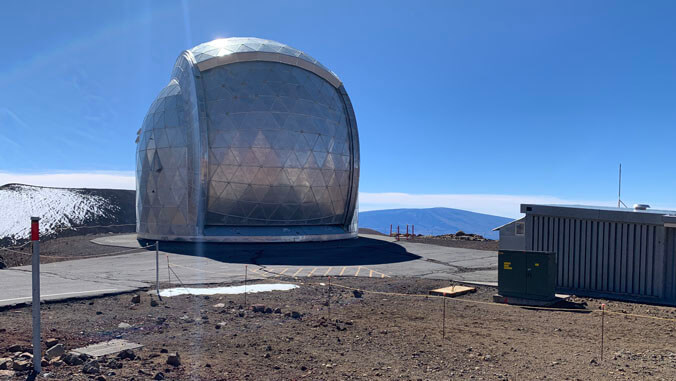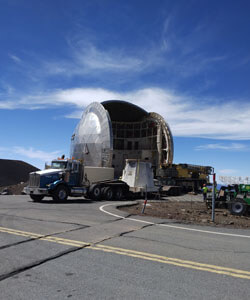 CSO dome gutted and set to be dismantled this coming spring.
CSO dome gutted and set to be dismantled this coming spring.
Removal of the 34-foot diameter telescope inside the Caltech Submillimeter Observatory (CSO) on Maunakea is complete and deconstruction of the dome is set to begin in spring. The final phase of the decommissioning process is expected to be completed by summer 2024 and will cost CSO more than $4 million.
CSO is the first observatory to be removed under the Decommissioning Plan of the University of Hawaiʻi Maunakea Comprehensive Management Plan. The removal of a second Maunakea observatory, the UH Hilo Hōkū Keʻa Telescope, is also scheduled to be completed in 2024.
“The CSO decommissioning is a complex and multi-phase project,” said Caltech physics professor and CSO Director Sunil Golwala. “We made a lot of progress this summer and fall. In the spring, when weather permits, we will resume decommissioning with the removal of the building that housed the telescope and restoration of the site.”
Decommissioning steps completed
The CSO on a truck.  Crews remove parts of the CSO telescope in September 2023.
Crews remove parts of the CSO telescope in September 2023.
- The telescope, including its mount, taken out of the observatory dome and removed from Maunakea.
- Cesspool confirmed to contain no remaining liquid contents.
- Interior demolition began and roll-off containers were filled with debris; insulation, drywall and plywood, and removed from Maunakea.
- Electrical power cut off from the observatory and the main circuit breaker is shut off. The electrical transformer feeding the site will be removed by Hawaiian Electric Company.
- Site inspected for rodents, as required by the county building permit.
- Underground utilities such as sewer, water, electrical, communication and grounding grids mapped using ground-penetrating radar so it can be located easily during the demolition process.
- Independent decommissioning construction monitor and a cultural monitor were present at all appropriate phases.
Final decommissioning phase
- Complete interior demolition and remove observatory dome
- Remove foundation and the cesspool, its remaining solid contents, and all underground utilities.
- Sample ground underneath the foundation and cesspool for chemicals of potential concern.
- Monitor site for the appearance of invasive species.
- Restore land to the fullest extent consistent with the permits guiding the decommissioning.
- Cultural, construction and archeological monitors will be present at all appropriate phases.
“Caltech will update the community once decommissioning resumes next year,” said Golwala. “Following the completion of restoration, the site will be monitored for three years, primarily to document repopulation by flora and fauna.”
The CSO deconstruction and site restoration on Maunakea is funded primarily by the Gordon and Betty Moore Foundation. The CSO telescope removal is made possible by the Heising-Simons Foundation. The telescope will be shipped to Chile for reuse.
Regular updates will be provided by
CSO.
.png)
 CSO dome gutted and set to be dismantled this coming spring.
CSO dome gutted and set to be dismantled this coming spring. Crews remove parts of the CSO telescope in September 2023.
Crews remove parts of the CSO telescope in September 2023.
-Horizontal-P301-w1920.png)
